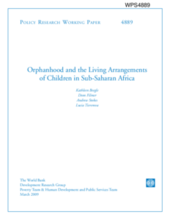Increasing adult mortality due to HIV/AIDS in Sub-Saharan Africa raises considerable concerns about the welfare of surviving children. Studies have found substantial variability across countries in the negative impacts of orphanhood on child health and education. One hypothesis for this variability is the resilience of the extended family network in some countries to care for orphans—networks under increasing pressure by the sheer number of orphans in many settings.
Using household survey data from 21 countries in Africa, this study examines trends in orphanhood and living arrangements, and the links between the two. The findings confirm that orphanhood is increasing, although not all countries are experiencing rapid rises. The evidence from these 21 countries suggests that in those countries with highest HIV rates, orphan rates have been increasing rapidly and it is grandparents who have been increasingly taking on responsibility for the care of orphaned children. At the same time some important changes in living arrangements even in countries with low prevalence levels are found, where orphan rates are not increasing. Based on these findings, not only should these changes and patterns be carefully tracked with subsequent rounds of data, but these changes need to be studied more carefully to understand underlying causes and implications. Moreover, the focus on changes in living arrangements should not focus narrowly on high HIV prevalence countries or on the population of orphans in these countries.

